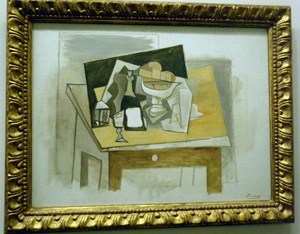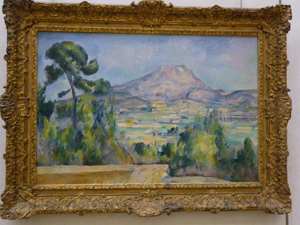
Picasso at the Orangerie
It seems that Picasso and I were never meant to be together, not really: by now, I’m pretty sure I was never meant to appreciate his art in person. Yes, I’ve seen a few random Picasso works — the famous Guernica, at the Reina Sofia modern art museum in Madrid, for example, or some of his early works at the Orangerie in Paris — but I have never been able to immerse myself in them completely. There are museums throughout the world dedicated to the works of Picasso, from Impressionism to Cubism and through Surrealism, but I have never been able to make it to even one of them. It’s not that I love the painter and seek him out everywhere I go, it’s just that whenever I try, it seems my efforts are always foiled.
Museums, at least the important ones in Europe, are closed one day a week. In Paris, most are closed on Tuesdays, in Spain, they’re closed on Mondays. Why they can’t be the same day is beyond me, but what’s even further beyond me is why I always seem to arrive in town on that day, the one day per week when everything is closed. I understand the need for an off day, but why that day is always the day I’m in town is something of a mystery.
The first time I travelled through Paris, my only full day in the city came on a Tuesday. Of course, many of the attractions like the Eiffel Tower were open, but the Louvre was closed, as was the Picasso museum. When I was in Barcelona, it was Monday, so again, no Picasso. Since this time I stayed in Paris for two months, I was sure I would make it. I’d have every day of the week up to and including Tuesdays to try to make it to the museum, so I wasn’t worried at all. Irony of ironies, when I finally made it to the Picasso museum (after wandering the streets of the Marais neighborhood, lost, for about half an hour), the sign taped to the door read: “Closed for renovations until 2012.” Sigh.
Now here I am in Aix-en-Provence, where the local museum has been advertising heavily for its temporary exhibition on Picasso and Cezanne, in which the works of the two artists were displayed side-by-side so visitors could see Cezanne’s influence on Picasso. In smaller print on the ads, which were taped to shop windows and printed on the backs of tourist brochures, were the dates for this exhibition: Summer 2009, ends September 27. Sigh, again.
However, this post is not about my inability to see Picasso. Well, not completely. It’s about how I found an alternative: I didn’t actually see any Picassos, but I probably came away understanding more about his work, and his influences on modern art, than if I had actually made it to one of the world museums dedicated to him.

Cezanne at the Orsay
The Musee Granet in Aix, the museum that had exhibited Picasso’s works alongside Cezanne’s this summer, had decided to extend its summer of Picasso. In addition to the temporary exhibition that I missed, they were also displaying an interactive exhibit called “Picasso: Metamorphoses,” which was held over until mid-December. Aha! (Also, owing to renovations, the museum wasn’t displaying all of its works, and so the entry was free. Aha, again!)
The thing about this exhibit, though, is that there weren’t actually any Picasso works displayed. It was all about reproductions and digital representations. So while I haven’t really broken my non-Picasso record, I have been exposed to his works, and his impact on art and the art world.
First I walked into a darkened room with mobiles hanging from ceiling to floor, each representing a year in the painter’s life, with several blocks attached to each one representing a painting or sculpture. It was remarkable how many there were, which I suppose is why there are multiple Picasso museums in the world and how they can all display original works (but not how I have been able to miss them all). Some of these blocks were lit up and inviting, and as soon as I touched them, a note would sound and a digital representation of the work would be projected onto the wall behind me.
This was coupled with a timeline of Picasso’s life on the opposite wall, which described the events and people in his life and the movements in the art world at the same time, and, by looking at how the pieces fit into the timeline, I was able to see how Picasso both influenced and was influenced by those people and trends.
The second room compared Cezanne’s works with Picasso’s. The display showed a plaster cast of a still life (fruit in a dish) in the center of the room. On either side, a projection of that still life painting by each artist was displayed. They came into view piece by piece, with the highlighting of each item first the way that Cezanne would have rendered it, and then as Picasso would have. What was apparent was how Cezanne’s revolutionary (at that time) style — blocks of color that built upon and on top of each other to create a cohesive whole, taking impressionism a step further — influenced Picasso’s work, and how he continued the trend, going from blocks of color to cubism. Despite the fact that there were no originals, it was fascinating to watch the progression and comparisons, and the breakdown of each painting into its simple and comparative parts was enlightening.
Following that room, I walked into a couple more rooms that showed scenes from a documentary made about Picasso in the 60s. I was amazed at the speed and skill with which he could paint a figure — though it was little more than a stylized version of a stick figure, it was obviously a woman, and still more obviously in his own recognizable style. Not knowing much about art, I probably might still have guessed it was painted by Picasso.
Going through that exhibit, I felt like I got to know a little more about art, and a little more about Picasso as well. I suppose it’s appropriate that I’ve learned more about art in three short months in France than I had in my entire life before that, despite the fact that I can’t seem to make it to a Picasso museum.

{ 1 comment… read it below or add one }
If the artist work continue to evade you – I have a friend in Seattle with a framed sketch drawing of his in their home. Rather small museum….. but available.
Funny blog…. I missed the big museum in Florence… walked through the awesome statuary outside, but never made it inside the doors!